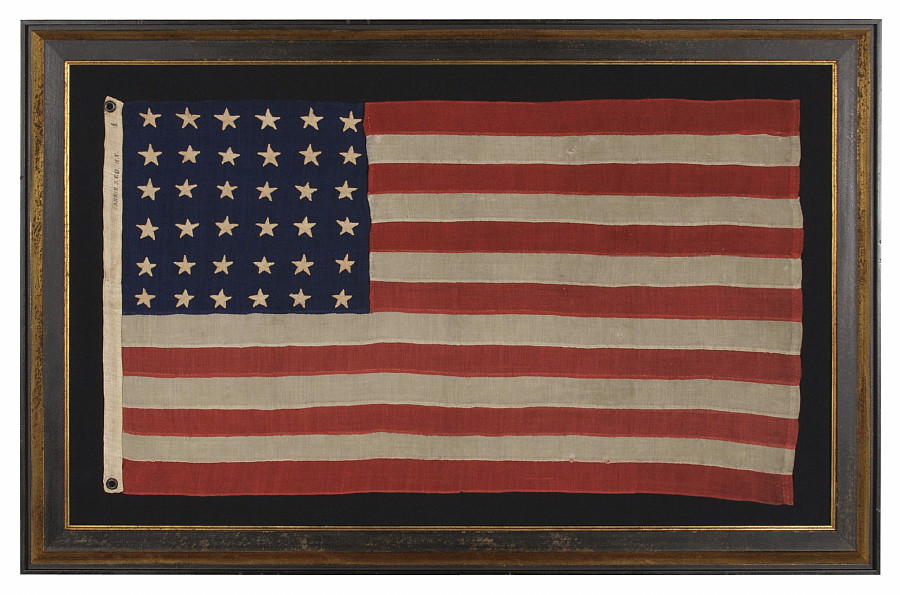
| |
36 STARS, CIVIL WAR ERA, MADE BY ANNIN IN NEW YORK CITY, IN AN UNUSUAL TINY SIZE FOR THE PERIOD AND ENTIRELY HAND-SEWN, NEVADA STATEHOOD, 1864-67 |
|
| Available: |
Sold |
| Frame Size (H x L): |
38.5" x 59" |
| Flag Size (H x L): |
27.5" x 48" |
|
| Description....: |
|
Entirely hand-sewn American national flag of the Civil War era with 36 stars, in a unusual and desirable small scale for the period (1864-67). The stars are made of cotton, hand-sewn, and single-appliqued. This means that they were applied to one side of the canton, then the blue fabric was cut from behind each star, folded over, and under-hemmed, so that one star could be viewed on both sides of the flag. I always find single-appliqued stars more interesting, not only because they are evidence of a more difficult level of seam-work and stitching, but also because they are more visually intriguing. Both the sewing itself and stretching of the fabrics over time results in stars that have irregular shapes and interesting visual qualities, which is certainly the case here. This is why flags with single-appliqued stars often appeal to connoisseurs of early American textiles. The two visible rows of hand-stitching emphasize their hand-sewn construction.
This flag was made by Annin in New City and is signed with a black stencil along the hoist binding that reads "Annin & Co., N.Y.". Annin is our nation's eldest flag-maker that is still in business today. The company was founded in the 1820's on the New York waterfront, incorporated in 1847, and, though it opened a large manufacturing operation in Verona, New Jersey in 1916, maintained its head office and some production in Manhattan until 1960. It is interesting to note that 36 is the lowest star count I have ever encountered on a flag with a Annin signature. While in business for at least 30 years by this time, it seems that the firm did not sign its flags before this period.
Adding to the appeal of this flag is its comparably tiny size when compared to others made for extended outdoor use prior to 1890. During the 19th century, flags with pieced and sewn construction (as opposed to printed) were typically eight feet long or larger. This is because they were important in their function as signals, meaning that they needed to be seen and recognized from a great distance. Even flags made for decorative purpose were generally very large by today's standards. A six-foot long flag was considered small. Production of flags smaller than this with sewn construction was near-to-non-existent, with the exception of infantry flank-markers and guidons, surviving examples of which are rare in the marketplace. Measuring just four feet on the fly, this flag is particularly tiny among its counterparts of the period. Since the average 19th century sewn flag can be cumbersome to frame and display in an indoor setting, many collectors prefer printed parade flags and smaller sewn flags, like this one.
The 36th state, Nevada, entered the Union during the Civil War on October 31st, 1864. The last Confederate general surrendered on May 26th, 1865. The 36 star flag became official on July 4th of that year, but makers of printed flags would have begun adding a 36th star to their flags in 1864, even before the addition of the new state occurred.
Lincoln pushed Nevada through just 8 days before the November election. Nevada's wealth in silver was attractive to a nation struggling with the debts of war and increased support for the Republican ticket. The 36 star flag was replaced by the 37 star flag in 1867, with the addition of Nebraska.
Construction: The canton and stripes are made of wool bunting. Wool sheds water and was the fabric of choice for extended outdoor use. That stars are made of cotton and the hoist binding is made of coarse linen with a brass grommet at either end. In addition to the Annin stencil, there is a number "4" to indicate size. All of the stitching is by hand. The stars are single-appliqued.
Mounting: The flag was stitched to 100% silk organza on every seam and throughout the star field for support. It was then sewn to a background of 100% cotton twill, black in color, which was washed to remove excess dye. An acid-free agent was added to the wash to further set the dye and the fabric was heat-treated for the same purpose. The mount was then placed in a black-painted, hand-gilded and distressed Italian molding. The glazing is U.V. protective acrylic.
Condition: Exceptional for the period with only a tiny amount of mothing. |
|
|
|
| Collector Level: |
Advanced Collectors and the Person with Everything |
|
| Flag Type: |
Sewn flag |
|
| Star Count: |
36 |
|
| Earliest Date of Origin: |
1864 |
|
| Latest Date of Origin: |
1867 |
|
| State/Affiliation: |
Nevada |
|
| War Association: |
1861-1865 Civil War |
|
| Price: |
SOLD |
|
| |
Views: 3709 |
|
|
|

